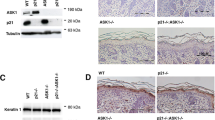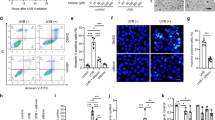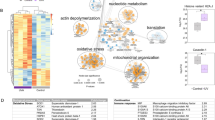Abstract
Previously, we have shown a role of cytosolic NAD(P)H:quinone oxidoreductase 1 (NQO1) in the stabilization of p63 against 20S proteasomal degradation resulting in thinning of the epithelium and chemical-induced skin cancer (Oncogene (2011) 30, 1098–1107). Current studies have demonstrated that NQO1 control of CCAAT-enhancer binding protein (C/EBPα) against 20S proteasomal degradation also contributes to the upregulation of p63 expression and protection. Western and immunohistochemistry analysis revealed that disruption of the NQO1 gene in mice and mouse keratinocytes led to degradation of C/EBPα and loss of p63 gene expression. p63 promoter mutagenesis, transfection and chromatin immunoprecipitation assays identified a C/EBPα-binding site between nucleotide position −185 and −174 that bound to C/EBPα and upregulated p63 gene expression. Co-immunoprecipitation and immunoblot analysis demonstrated that 20S proteasomes directly interacted and degraded C/EBPα. NQO1 direct interaction with C/EBPα led to stabilization of C/EBPα against 20S proteasomal degradation. NQO1 protection of C/EBPα required binding of NADH with NQO1. Exposure of skin and keratinocytes to the chemical stress agent benzo(a)pyrene led to induction of NQO1 and stabilization of C/EBPα protein, resulting in an increase in p63 RNA and protein in wild-type but not in NQO1−/− mice. Collectively, the current data combined with previous data suggest that stress induction of NQO1 through both stabilization of C/EBPα and increase in p63 and direct stabilization of p63 controls keratinocyte differentiation, leading to protection against chemical-induced skin carcinogenesis. The studies are significant as 2–4% human individuals are homozygous and 23% are heterozygous for the NQO1P187S mutation and might be susceptible to stress-induced skin diseases.
This is a preview of subscription content, access via your institution
Access options
Subscribe to this journal
Receive 50 print issues and online access
$259.00 per year
only $5.18 per issue
Buy this article
- Purchase on Springer Link
- Instant access to full article PDF
Prices may be subject to local taxes which are calculated during checkout






Similar content being viewed by others
References
Adler J, Reuven N, Kahana C, Shaul Y . (2010). c-Fos proteasomal degradation is activated by a default mechanism, and its regulation by NAD(P)H:quinone oxidoreductase 1 determines C-Fos serum response kinetics. Mol Cell Biol 30: 3767–3778.
Ahn KS, Sethi G, Jain AK, Jaiswal AK, Aggarwal BB . (2006). Genetic deletion of NAD(P)H:quinone oxidoreductase 1 abrogates activation of nuclear factor-kappaB, IkappaBalpha kinase, c-Jun N-terminal kinase, Akt, p38, and p44/42 mitogen-activated protein kinases and potentiates apoptosis. J Biol Chem 281: 19798–19808.
Asher G, Loten J, Cohen B, Sachs L, Shaul Y . (2001). Regulation of p53 stability and p53-dependent apoptosis by NADH quinone oxidoreductase 1. Proc Natl Acad Sci USA 98: 1188–1193.
Asher G, Loten J, Sachs L, Kahana C, Shaul Y . (2002). Mdm-2 and ubiquitin-independent p53 proteasomal degradation regulated by NQO1. Proc Natl Acad Sci USA 99: 13125–13130.
Asher G, Tsvetkov P, Kahana C, Shaul Y . (2005). A mechanism of ubiquitin-independent proteasomal degradation of the tumor suppressors p53 and p73. Genes Dev 19: 316–321.
Garate M, Wong RPC, Campos EI, Wang Y, Gang Li . (2008). NAD(P)H:quinone oxidoreductase 1 inhibits the proteasomal degradation of the tumour suppressor p33ING1b. EMBO Rep 9: 576–581.
Gong X, Kole L, Iskander K, Jaiswal AK . (2007). NRH:quinone oxidoreductase 2 and NAD(P)H:quinone oxidoreductase 1 protect tumor suppressor p53 against 20S proteasomal degradation leading to stabilization and activation of p53. Cancer Res 67: 5380–5388.
Higashikawa K, Yoneda S, Tobiume K, Taki M, Shigeishi H, Kamata N . (2007). Snail-induced down-regulation of deltaNp63alpha acquires invasive phenotype of human squamous cell carcinoma. Cancer Res 67: 9207–9213.
Iskander K, Gaikwad A, Paquet M, Long DJ, Brayton C, Barrios R et al. (2005). Lower induction of p53 and decreased apoptosis in NQO1-null mice leads to increased sensitivity of chemical-induced carcinogenesis. Cancer Res 65: 2054–2058.
Jaiswal AK, Bell DW, Radjendirane V, Testa JR . (1999). Localization of human NQO1 gene to chromosome 16q22 and NQO2–6p25 and associated polymorphism. Pharmacogenetics 9: 413–418.
Kaspar JW, Niture SK, Jaiswal AK . (2009). Nrf2:INrf2 (Keap1) signaling in oxidative stress. Free Radic Biol Med 47: 1304–1309.
King KE, Weinberg WC . (2007). P63: defining roles in morphogenesis, homeostasis, and neoplasia of the epidermis. Mol Carcinog 46: 716–724.
Long II DJ, Jaiswal AK . (2000). NRH:quinone oxidoreductase2 (NQO2). Chem Biol Interact 129: 99–112.
Long II DJ, Waikel RL, Wang XJ, Perlaky L, Roop DR, Jaiswal AK . (2000). NAD(P)H:quinine oxidoreductase 1 deficiency increases susceptibility to benzo(a)pyrene induced mouse skin carcinogenesis. Cancer Res 60: 5913–5915.
Long II DJ, Waikel RL, Wang XJ, Roop DR, Jaiswal AK . (2001). NAD(P)H:quinine oxidoreductase1 deficiency and increased susceptibility to 7,12-dimethylbenz[a]-anthracene-induced carcinogenesis in mouse skin. J Natl Cancer Inst 93: 1166–1170.
Mills AA, Zheng B, Wang XJ, Vogel H, Roop DR, Bradley A . (1999). p63 is a p53 homologue required for limb and epidermal morphogenesis. Nature 398: 708–713.
Moll UM, Slade N . (2004). p63 and p73: roles in development and tumor formation. Mol Cancer Res 2: 371–386.
Patrick BA, Gong X, Jaiswal AK . (2011). Disruption of NAD(P)H:quinone oxidoreductase 1 gene in mice leads to 20S proteasomal degradation of p63 resulting in thinning of epithelium and chemical-induced skin cancer. Oncogene 30: 1098–1107.
Pietsch EC, Sykes SM, McMahon SB, Murphy SE . (2008). The p53 family and programmed cell death. Oncogene 27: 6507–6521.
Radjendirane V, Joseph P, Lee YH, Kimura S, Klein-Szanto AJ, Gonzalez FJ et al. (1998). Disruption of the DT diaphorase (NQO1) gene in mice leads to increased menadione toxicity. J Biol Chem 273: 7382–7389.
Ross D . (2004). Quinone reductases multitasking in the metabolic world. Drug Metab Rev 36: 639–654.
Siegel D, Anwar A, Winski SL, Kepa JK, Zolman KL, Ross D . (2001). Rapid polyubiquitination and proteasomal degradation of a mutant form of NAD(P)H:quinone oxidoreductase 1. Mol Pharmacol 59: 263–268.
Sigrist CJA, Cerutti L, de Castro E, Langendijk-Genevaux PS, Bulliard V, Bairoch A et al. (2010). PROSITE, a protein domain database for functional characterization and annotation. Nucleic Acids Res 38: 161–166.
Traver RD, Horikoshi T, Danenberg KD, Stadlbaur THW, Danenberg PV, Ross D et al. (1992). NAD(P)H:quinone oxidoreductase gene expression in human colon carcinoma cells: characterization of a mutation which modulates DT-diaphorase activity and mitomycin sensitivity. Cancer Res 52: 797–802.
Vasiliou V, Ross D, Nebert DW . (2006). Update of the NAD(P)H:quinone oxidoreductase (NQO) gene family. Hum Genomics 2: 329–335.
Zhang Y, Kensler TW, Cho C, Posner GH, Talalay P . (1994). Anticarcinogenic activities of sulforaphane and structurally related synthetic norbornyl isothiocyanates. Proc Natl Acad Sci USA 91: 3147–3150.
Acknowledgements
We thank our colleagues for helpful discussions and suggestions. This study was supported by NIH Grant RO1 ES007943. BAP was partly supported by grant ES007263. AKJ was supported by NIEHS grant RO1 ES007943. BAP was supported by grant RO1 ES007943 and also in part is supported by NIEHS training grant ES007263.
Author information
Authors and Affiliations
Corresponding author
Ethics declarations
Competing interests
The authors declare no conflict of interest.
Additional information
Supplementary Information accompanies the paper on the Oncogene website
Rights and permissions
About this article
Cite this article
Patrick, B., Jaiswal, A. Stress-induced NQO1 controls stability of C/EBPα against 20S proteasomal degradation to regulate p63 expression with implications in protection against chemical-induced skin cancer. Oncogene 31, 4362–4371 (2012). https://doi.org/10.1038/onc.2011.600
Received:
Revised:
Accepted:
Published:
Issue Date:
DOI: https://doi.org/10.1038/onc.2011.600
Keywords
This article is cited by
-
E47 upregulates ΔNp63α to promote growth of squamous cell carcinoma
Cell Death & Disease (2021)
-
A tumor suppressor role for C/EBPα in solid tumors: more than fat and blood
Oncogene (2017)
-
Down-regulation of the expression of CCAAT/enhancer binding protein α gene in cervical squamous cell carcinoma
BMC Cancer (2014)



